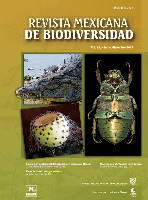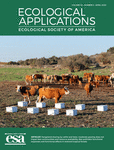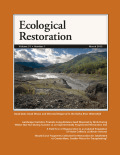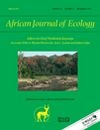
BIOLOGICAL INVASIONS
Scope & Guideline
Exploring the dynamics of biodiversity in the face of invasion.
Introduction
Aims and Scopes
- Ecological Impacts of Invasive Species:
Research articles explore the ecological consequences of invasive species on native biodiversity, ecosystem functions, and community structures, often employing experimental and observational studies. - Management and Control Strategies:
The journal emphasizes applied research that evaluates methods for managing invasive species, including biological control, habitat restoration, and policy implications. - Dispersal Mechanisms and Pathways:
Numerous studies investigate the pathways and mechanisms by which invasive species spread, including anthropogenic factors, natural dispersal, and climate change influences. - Genetic and Phenotypic Studies:
Research often includes genetic analyses to understand the adaptations of invasive species, their interactions with native species, and the implications of hybridization. - Social and Economic Dimensions:
The journal also addresses the socio-economic aspects of invasions, including public perceptions, economic impacts, and stakeholder engagement in management practices. - Climate Change Interactions:
A growing focus on how climate change affects the success and distribution of invasive species, and how invasive species, in turn, impact climate resilience.
Trending and Emerging
- Use of Environmental DNA (eDNA):
There is a rising trend in using eDNA for detecting and monitoring invasive species, allowing for more efficient and non-invasive sampling methods across diverse environments. - Interdisciplinary Approaches:
Research increasingly integrates ecological, genetic, and socio-economic perspectives to provide comprehensive insights into invasions and their management. - Climate Change and Invasive Species Interactions:
Studies focusing on the interplay between climate change and invasive species dynamics are gaining traction, emphasizing the need to understand how shifting climates affect invasion processes. - Community and Ecosystem Resilience:
Emerging research is exploring how invasive species affect community resilience and the potential for native species recovery following invasions. - Technological Innovations in Monitoring:
The application of remote sensing, machine learning, and other technological advancements is trending, enhancing the ability to predict and monitor invasive species distributions.
Declining or Waning
- Historical Case Studies of Invasions:
There is a noticeable decline in the publication of historical case studies that document past invasions, which previously provided context and lessons for current management strategies. - Focus on Single Species Studies:
Research concentrating exclusively on single invasive species is waning, as there is a shift towards understanding multi-species interactions and community-level impacts. - Laboratory-Based Research:
The reliance on laboratory experiments to study invasions is decreasing in favor of field-based studies that capture the complexity of ecological interactions in natural settings. - Regional Studies:
There is less emphasis on localized studies of invasions in specific regions, as the journal's focus expands to encompass broader, global perspectives on invasions.
Similar Journals

Revista Mexicana de Biodiversidad
Illuminating the Path to Biodiversity PreservationRevista Mexicana de Biodiversidad is a prominent academic journal dedicated to the field of biodiversity and conservation, published by the prestigious Instituto de Biología, Universidad Nacional Autónoma de México. Since its inception as an Open Access publication in 2005, it has aimed to disseminate high-quality research that advances the understanding of biological diversity in Mexico and beyond. With an ISSN of 1870-3453 and an E-ISSN of 2007-8706, the journal caters to a diverse audience, including researchers, professionals, and students, by providing vital insights into ecological studies, conservation strategies, and the sustainable management of natural resources. The journal is committed to fostering scientific collaboration and promoting the significance of biodiversity in addressing contemporary environmental challenges. By publishing innovative and impactful research, the Revista Mexicana de Biodiversidad plays an essential role in the global discourse on biodiversity conservation.

ECOLOGICAL APPLICATIONS
Connecting research to conservation for impactful change.ECOLOGICAL APPLICATIONS, published by WILEY, is a leading journal in the field of ecology, providing a platform for innovative research that addresses the understanding and management of ecological systems. With an ISSN of 1051-0761 and E-ISSN of 1939-5582, it has established itself as a vital resource for ecologists and environmental scientists since its inception in 1991. Ranked in the top quartile (Q1) for Ecology in 2023 and with a Scopus ranking of 40 out of 461 in Environmental Science, ECOLOGICAL APPLICATIONS boasts an impressive impact factor, attesting to its significance and influence in the field. The journal's mission is to publish peer-reviewed articles that contribute to ecological theory and its applications in conservation and environmental management. Researchers, professionals, and students alike will find invaluable insights and the latest developments in ecological research through its comprehensive scope and rigorous scholarship, ensuring a crucial role in shaping future ecological practices and policies.

Ecological Restoration
Pioneering solutions for a sustainable planet.Ecological Restoration is a renowned journal published by University of Wisconsin Press, focusing on the critical and evolving field of ecological restoration. With its inception dating back to 1999 and converging through the years to 2024, the journal has carved out a significant niche, reflected in its recognition within the Q3 category of Nature and Landscape Conservation for 2023. Although the journal is not readily available as open access, it offers an essential platform for researchers, professionals, and students to publish their findings and collaborate across diverse topics relevant to environmental science and restoration practices. Ranked #123 out of 211 in its Scopus category and positioned in the 41st percentile, Ecological Restoration is dedicated to advancing the dialogue surrounding restoration techniques, ecological health, and sustainability efforts in response to ongoing global environmental challenges. This makes it a vital resource for anyone committed to enhancing the integrity of our natural ecosystems.

Management of Biological Invasions
Leading the Charge Against Biological InvasionsManagement of Biological Invasions, published by the Regional Euro-Asian Biological Invasions Centre (REABIC), is a prominent open access journal that has been contributing to the field of ecological science since its inception in 2010. With an ISSN of 1989-8649 and a commendable presence in various ranking categories, it maintains a Q2 ranking in Ecology and Ecology, Evolution, Behavior and Systematics, as well as a Q3 ranking in Management, Monitoring, Policy and Law. This journal is vital for researchers, professionals, and students focused on understanding and managing biological invasions, a pressing issue that affects biodiversity and ecosystem health globally. Operating from Finland, “Management of Biological Invasions” fosters innovative research and facilitates discourse on management strategies through its rigorous peer-review process and dynamic publication schedule, ensuring accessibility for the academic community. As it converges years from 2010 to 2024, the journal continues to serve as a key platform for disseminating knowledge that informs policy, supports ecological resilience, and ultimately guides sustainable management practices.

ECOLOGICAL RESEARCH
Fostering innovation in ecology for a sustainable future.ECOLOGICAL RESEARCH is a prestigious academic journal published by WILEY, dedicated to advancing the field of ecology and its associated disciplines. Since its inception in 1986, the journal has consistently provided a platform for high-quality, peer-reviewed research, contributing significantly to the understanding of ecological systems and their complexities. With an impressive 2023 impact factor reflected in its Q1 ranking in the category of Ecology, Evolution, Behavior, and Systematics, it stands among the top journals in its field, as evidenced by its Scopus rank of #192 out of 721 and placement in the 73rd percentile. While accessible through standard subscription models, this journal plays an essential role in disseminating crucial findings and innovative methodologies to researchers, professionals, and students alike. With a commitment to fostering ecological knowledge and collaboration, ECOLOGICAL RESEARCH continues to influence ecological practices and policies, shaping the future of research in this critical area.

WETLANDS ECOLOGY AND MANAGEMENT
Driving impactful research in wetlands ecology.Wetlands Ecology and Management, published by Springer, is an esteemed journal that has been advancing the field of wetland studies since its inception in 1982. Operating under the ISSN 0923-4861 and E-ISSN 1572-9834, this journal is headquartered in the Netherlands and serves as a critical resource for researchers, professionals, and students alike. It fosters interdisciplinary dialogue among aquatic science, ecology, and resource management disciplines, ranking in the Q2 category for Aquatic Science and Ecology, Evolution, Behavior and Systematics as of 2023. With a notable Scopus ranking, it is positioned favorably within the 65th percentile in Ecology and a commendable 58th percentile in Aquatic Sciences. The journal emphasizes the importance of effective management strategies and policies in the conservation of wetlands, making it indispensable for those aiming to drive impactful research. Although it is not an open-access journal, its high-quality publications remain accessible through library consortia and institutional subscriptions, ensuring that pertinent insights into the ecological dynamics and sustainable management practices are available to the global research community.

AFRICAN JOURNAL OF ECOLOGY
Unveiling the Secrets of African EcosystemsThe African Journal of Ecology, published by Wiley, is a leading academic journal in the field of Ecology, Evolution, Behavior, and Systematics. Established in 1963 and continuing its vital contributions to the field until 2024, this journal serves as a premier platform for researchers and scholars to share groundbreaking studies that explore the intricate relationships within ecosystems, particularly in the African context. With an impressive Scopus Rank of #423 out of 721 and a Q3 Quartile ranking, it stands as a credible source of scholarly information, gaining recognition among peers for its rigorous peer-review process and impactful publications. While the journal is not open access, it remains influential in driving advancements in ecological research and providing insights vital for conservation efforts and biodiversity studies. Authors and readers alike will find that the African Journal of Ecology not only promotes scientific inquiry but also fosters a deeper understanding of ecological dynamics that affect our world.

RESTORATION ECOLOGY
Advancing the Science of Ecological RenewalRESTORATION ECOLOGY is a leading international journal dedicated to the science and practice of ecological restoration, published by WILEY. With an ISSN of 1061-2971 and a robust E-ISSN of 1526-100X, this journal has successfully positioned itself within the top quartiles (Q1) in significant categories such as Ecology, Evolution, Behavior and Systematics, and Nature and Landscape Conservation, showcasing its high-impact contributions to these vital fields. RESTORATION ECOLOGY has been actively disseminating critical research since 1993 and continues to thrive as it converges toward 2024. Ranked impressively within Scopus, it stands at #98 out of 721 in Agricultural and Biological Sciences and #30 out of 211 in Environmental Science, emphasizing its substantial influence and reach. While the journal operates under traditional access guidelines, it serves as an invaluable resource for researchers, professionals, and students alike, aiming to advance knowledge and practical solutions for biodiversity conservation and ecosystem rehabilitation globally. For those interested in the intersection of ecological theory and practical restoration applications, RESTORATION ECOLOGY is a key outlet for fostering dialogue and collaboration.

Frontiers in Ecology and Evolution
Unveiling the complexities of life through ecology and evolution.Frontiers in Ecology and Evolution, published by FRONTIERS MEDIA SA, stands as a premier open-access journal dedicated to the exploration and discourse in the interdisciplinary fields of ecology and evolutionary biology. With its inception in 2013, this journal has rapidly ascended to a prestigious position, securing a Q1 ranking in both Ecology and Ecology, Evolution, Behavior and Systematics categories, reflecting its influential impact in the respective fields. Operative from Switzerland, Frontiers in Ecology and Evolution enables researchers, professionals, and students to access high-quality research without barriers, promoting collaboration and innovation. The journal covers a broad range of topics, from ecological dynamics to evolutionary strategies, facilitating profound insights that drive scientific advancement and understanding. With a remarkable position in Scopus rankings—ranking #218 in Ecology, Evolution, Behavior and Systematics and #145 in Environmental Science—this journal is essential for anyone keen on contributing to or staying updated with contemporary research in ecology and evolution.

AMPHIBIAN & REPTILE CONSERVATION
Empowering Conservationists with Open Access KnowledgeAMPHIBIAN & REPTILE CONSERVATION, published by the Amphibian Conservation Research Center & Lab, is a leading journal dedicated to the field of herpetology and environmental conservation. With an ISSN of 1083-446X and an E-ISSN of 1525-9153, this journal serves as a vital resource for researchers, conservationists, and students interested in the preservation of amphibian and reptile species. The journal has achieved remarkable rankings, categorized in the Q2 quartile for Animal Science and Zoology, Ecology, and Nature and Landscape Conservation as of 2023, reflecting its significant contribution to the scientific community. Over the converged years from 2016 to 2024, the journal has established itself as an integral platform for disseminating research findings, fostering collaboration, and enhancing the understanding of biodiversity and ecosystem dynamics. By embracing an open-access approach, AMPHIBIAN & REPTILE CONSERVATION ensures that critical research is readily available to a global audience, promoting informed conservation efforts and policy advocacy to safeguard these vital species amidst their declining populations.